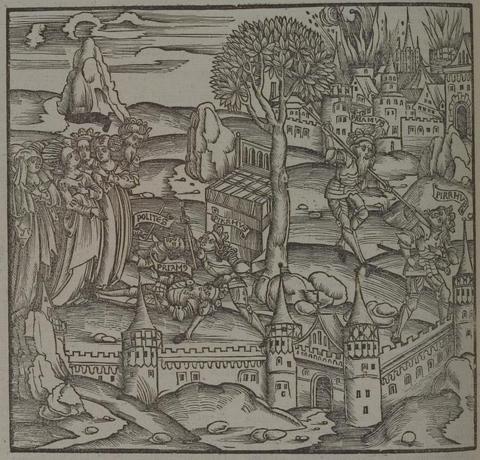Annotations
On the right side of the image, old king Priam chases Pyrrhus (Neoptolemus) with his spear (544-5); the awkward angle makes it look as though Priam has stabbed Pyrrhus in the neck, but this is not the case. On the left, Priam lies on his back, and Pyrrhus holds the king's head up by holding his hair in his left hand; he aims his sword at the king's shoulder, about to stab him (549-53). Polites, the son of Priam whom Pyrrhus killed earlier in lines 526-32, lies nearby. To the left of the slaughter, stands a group of people, mainly the wife and daughters of Priam. The man standing with them might be Aeneas. The slaughter happens near an altar that stands next to a laurel tree in an inner courtyard in the palace (512-4); Brant portrays it as a large Christian altar sitting awkwardly next to a tree in the middle of an open grassy area. In the top right corner, the citadel burns; at the bottom of the image is the outer wall of the city. (Katy Purington)
Woodcut illustration from the “Strasbourg Vergil,” edited by Sebastian Brant: Publii Virgilii Maronis Opera cum quinque vulgatis commentariis expolitissimisque figuris atque imaginibus nuper per Sebastianum Brant superadditis (Strasbourg: Johannis Grieninger, 1502), fol. 174v, executed by an anonymous engraver under the direction of Brant.


Sebastian Brant (1458–1521) was a humanist scholar of many competencies. Trained in classics and law at the University of Basel, Brant later lectured in jurisprudence there and practiced law in his native city of Strasbourg. While his satirical poem Das Narrenschiff won him considerable standing as a writer, his role in the transmission of Virgil to the Renaissance was at least as important. In 1502 he and Strasbourg printer Johannes Grüninger produced a major edition of Virgil’s works, along with Donatus’ Life and the commentaries of Servius, Landino, and Calderini, with more than two hundred woodcut illustrations. (Annabel Patterson)